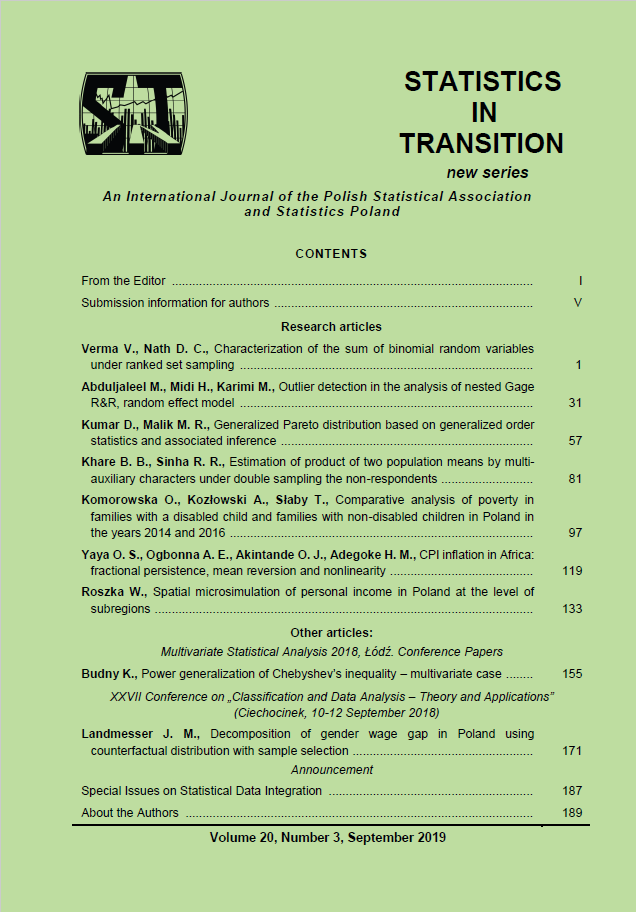ARTICLE
ABSTRACT
The presence of a child with disabilities in a family presents more challenging conditions than the presence of a non-disabled child. One of the difficulties is of financial nature. One of the parents often has to give up their job to care for the child, which shrinks the household income. At the same time, the family has higher expenses resulting from, e.g. costs of treatment. All this increases the risk of falling into poverty. The goal of this paper is to analyse the financial situation of households with a disabled child, mainly in the context of poverty, and compare it to the financial situation of households with non-disabled children. The study is based on data from Polish Household Budget Survey, covering two years, 2014 and 2016. The study revealed that families with a disabled child are generally poorer than families with non-disabled children. The financial situation improved over the studied period in both types of families, but the improvement in the families with a disabled child was much greater. The main factor in reducing the risk of poverty in both types of families is the education attainment level of the reference person (the household head), which should be at least upper secondary.
KEYWORDS
households with a disabled child, factors related to poverty, Household Budget Survey, logistic regression
REFERENCES
ANYAEGBU, G., (2010). Using the OECD equivalence scale in taxes and benefits analysis. Economic & Labour Market Review, 4(1), pp. 49–54.
BIRD, K., (2013). The Intergenerational Transmission of Poverty: An Overview. In: A. Shepherd and J. Brunt, eds. Chronic Poverty: Concepts, Causes and Policy, Rethinking International Development Series. London: Palgrave Macmillan UK. pp. 60–84.
COWELL, F., (2011). Measuring Inequality, Oxford University Press.
EUROPEAN COMMISSION, (2010). Communication from the Commission, Europe 2020, A strategy for smart, sustainable and inclusive growth, Brussels.
FAHRMEIR, L., KNEIB, T., LANG, S., MARX, B., (2013). Regression, Models, methods and applications, Heidelberg: Springer.
GATNAR, E., (2001). Nieparametryczna metoda dyskryminacji i regresji, Warszawa: Wydawnictwo Naukowe PWN.
GŁÓWNY URZĄD STATYSTYCZNY, (2015a). Ubóstwo w Polsce w latach 2013-2014, Warszawa: GUS.
GŁÓWNY URZĄD STATYSTYCZNY, (2015b). Aneks tabelaryczny do opracowania sygnalnego Ubóstwo ekonomiczne w Polsce w 2014 r. Warszawa: GUS.
GŁÓWNY URZĄD STATYSTYCZNY, (2017a). Zasięg ubóstwa ekonomicznego w Polsce w 2016 roku, Warszawa: GUS.
GŁÓWNY URZĄD STATYSTYCZNY, (2017b). Ubóstwo w Polsce w latach 2015 i 2016, WARSZAWA: GUS.
GŁÓWNY URZĄD STATYSTYCZNY, (2018). Zasięg ubóstwa ekonomicznego w Polsce w 2017 roku, Warszawa: GUS.
GOLINOWSKA, S., MARECKA, Z., STYRC, M., CUKROWSKA, E., CUKROWSKI, J., (2008), Od ubóstwa do wykluczenia społecznego. Warszawa: IPiSS.
HAGENAARS, A., DE VOS, K., ZAIDI, M. A., (1994). Poverty statistics in the late 1980s: research based on micro-data, Luxembourg: Office for Official Publications of the European Communities.
HARPER, C., MARCUS, R., MOORE, K., (2003). Enduring Poverty and the Conditions of Childhood: Lifecourse and Intergenerational Poverty Transmissions. World Development, 31(3), pp. 535–554.
HARRELL, F. E. J., (2015). Regression modeling strategies, Heidelberg: Springer.
KLUGMAN, J., (2002). A sourcebook for poverty reduction strategies, Vol. 1: Core Techniques and Cross-Cutting Issues, Washington: The World Bank.
KRUSZYŃSKI, K., WARZYWODA-KRUSZYŃSKA, W., (2011). Dziedziczenie biedy i wykluczenia społecznego – w perspektywie lokalnej polityki społecznej. In: R. Szarfenberg, ed. 2011, Ubóstwo i wykluczenie społeczne w Polsce, Warszawa: Kampania Przeciw Homofobii. pp. 49–55.
LISICKA I., (2013). Pomiar ubóstwa gospodarstw domowych w Polsce – ujęcie klasyczne, Ekonomika i Organizacja Gospodarki Żywnościowej, (102), pp. 37–48.
ŁUKASIEWICZ, P., KOSZELA, G., ORŁOWSKI, A., (2006). Wpływ wyboru skali ekwiwalentności na wyniki w zakresie pomiaru ubóstwa i koncentracji dochodów. Ekonomika i Organizacja Gospodarki Żywnościowej, 60, pp. 207–217.
PANEK, T., (2011). Ubóstwo, wykluczenie społeczne i nierówności. Teoria I Praktyka Pomiaru, Warszawa: Oficyna Wydawnicza SGH.
PANEK, T., (2014). Ubóstwo i wykluczenie społeczne. In: T. Panek, ed. 2014. Statystyka Społeczna, Warszawa: PWE.
SZARFENBERG, R., SZEWCZYK, Ł., (2010). Badania ubóstwa – perspektywa ilościowa i jakościowa. In: R. Szarfenberg, C. Żołędowski, M. Theiss, eds. 2010, Ubóstwo i wykluczenie społeczne – perspektywa poznawcza. Warszawa: ELIPSA.
THON, D., (1979). On Measuring Poverty. Review of Income and Wealth, 25(4), pp. 429–439.
